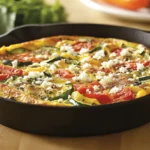When it comes to making the perfect frittata, the right cookware can make all the difference. If you’re tired of your frittata sticking, overcooking, or just not turning out as expected, you probably need a reliable frittata pan. But with so many options out there, how do you pick the one that’s right for you? Let’s dive into everything you need to know about frittata pans—what they are, why you need one, and how to choose the best one for your kitchen.
What is a Frittata Pan?
A frittata pan is specially designed to cook frittatas, a classic Italian egg dish often filled with vegetables, meats, cheeses, and herbs. Unlike omelets or scrambled eggs, frittatas are cooked more slowly and at a lower temperature, often requiring both the stovetop and the oven to finish.

Understanding the Difference Between a Frittata Pan and Other Cookware
You might be wondering: What’s the difference between a frittata pan and a regular skillet? Well, while you can technically make a frittata in any pan, a frittata pan has specific features that make it perfect for this dish. These pans tend to have:
- Low sides: To help evenly distribute heat and ensure the frittata cooks properly.
- Lid or oven-safe: Many frittata pans come with a lid to help steam the frittata and make sure it cooks through without drying out.
- Nonstick surface: This prevents the delicate frittata from sticking and allows for easy flipping or removal.
So, if you’re serious about making perfect frittatas every time, investing in a pan specifically designed for the job is a game-changer. Trust us, it’s worth it.
Why You Need a Frittata Pan for Perfect Italian Eggs
Now, let’s talk about why a frittata pan is essential. After all, why go out of your way to buy yet another kitchen tool when you can just use a regular frying pan? Here’s why:
Benefits of Using a Frittata Pan
- Even Heat Distribution: A frittata pan provides uniform heat throughout cooking, preventing unevenly cooked eggs.
- Perfect Flip: The lower sides and nonstick surface make flipping or removing the frittata easy—no more broken eggs or flipping disasters! (We’ve all been there.)
- Versatility: While it’s designed for frittatas, the pan can also be used for other dishes, such as scrambled eggs, quiches, and small one-pan meals.
- Oven-Friendly: A good frittata pan can go from stovetop to oven without any issues. Finishing your frittata under the broiler or cooking it through without overcooking the edges is especially helpful.

Key Features to Look for in a Frittata Pan
When shopping for a frittata pan, look for specific features. Let’s break down what makes a frittata pan special.
Size and Shape: Choosing the Right Dimensions
Frittatas can be made in various sizes, from personal portions to larger, family-friendly servings. Here’s a quick guide:
| Pan Size | Number of Servings |
|---|---|
| 8-inch | 2-4 servings |
| 10-inch | 4-6 servings |
| 12-inch | 6-8 servings |
- 8-inch pans are perfect for smaller servings or if you’re cooking for one or two people.
- 10-inch pans are great for families or when you want more room for extra fillings.
- 12-inch pans work well for large groups, but remember that the frittata may take longer to cook through.
Material Matters: Cast Iron, Nonstick, or Stainless Steel?
The material of your frittata pan affects cooking performance, heat distribution, and cleanup. Here’s what to consider:
- Cast Iron pans are known for their excellent heat retention and even cooking. Cast iron might be the way to go if you’re looking for a pan that lasts for years (and can even be used in the oven).
- Nonstick: This pan is perfect for beginners or anyone who struggles with food sticking. It is easy to clean but may not last as long as cast iron or stainless steel.
- Stainless Steel: These pans are durable, non-reactive, and easy to clean. However, they require a bit more attention to avoid sticking.

Handles, Lids, and Other Design Features
A frittata pan should have a heat-resistant handle for easy maneuvering. Some pans even come with a second handle or looped handles for more secure lifting.
A good frittata pan will have a lid that’s either included or compatible with the pan. Lids help steam the frittata and ensure it cooks evenly.
Top 5 Frittata Pans on the Market: A Comparison
If you’re on the hunt for the perfect frittata pan, here are five top options you should consider:
1. Lodge Pre-Seasoned Cast Iron Frittata Pan
- Features: Cast iron construction, pre-seasoned for nonstick performance, oven safe.
- Pros: Exceptional heat retention, durable, perfect for both stovetop and oven.
- Cons: Heavy, requires proper care and maintenance.
2. Calphalon Classic Nonstick Frittata Pan
- Features: Hard-anodized aluminum, dual-layer nonstick coating, oven safe to 400°F.
- Pros: Lightweight, easy to clean, affordable.
- Cons: Less durable than cast iron, may warp over time.
3. Cuisinart Chef’s Classic Stainless Steel Frittata Pan
- Features: Stainless steel construction, cool-touch handle, dishwasher safe.
- Pros: Long-lasting, great for high-heat cooking, easy to clean.
- Cons: It requires extra care to prevent sticking and can be a bit pricey.
How to Use a Frittata Pan: A Step-by-Step Guide
If you’re new to using a frittata pan, don’t worry—we’ve got you covered! Here’s how to use your pan to create a perfect frittata.
Prepping the Ingredients for a Perfect Frittata
Before you start, gather your favorite frittata ingredients. Typically, you’ll want:
- Eggs (usually 6-8, depending on pan size)
- Vegetables (like onions, spinach, bell peppers)
- Cheese (cheddar, mozzarella, or Parmesan)
- Herbs and spices (oregano, thyme, salt, and pepper)
- Protein (optional: bacon, sausage, or chicken)
Cooking Techniques and Tips for Even Heating
- Preheat the Pan: Heat your pan on medium heat before adding any ingredients. If you’re using nonstick or cast iron, avoid overheating it to avoid damage.
- Sauté Veggies: Start by sautéing your vegetables (and protein) in olive oil until softened.
- Add Eggs: Beat the eggs and pour them into the pan over the sautéed ingredients.
- Even Cooking: Use a spatula to gently stir the edges of the eggs as they cook, allowing the uncooked eggs to flow to the edges. Once the bottom is set, reduce the heat.
Finishing the Frittata: Broiling or Baking in the Pan?
After the eggs are mostly set, it’s time to finish off the frittata. You can either:
- Broil: Place the pan under the broiler for 2-4 minutes to set the top.
- Bake: Alternatively, if your frittata pan is oven-safe, bake the frittata at 375°F for about 10 minutes until fully set.
Common Problems with Frittata Pans and How to Solve Them
Let’s talk about some common issues people run into with frittata pans and how to fix them:
My Frittata Won’t Slide Out of the Pan: Solutions
This is a common problem, especially with pans that aren’t properly seasoned or are low-quality nonstick. If this happens, try these tips:
- Make sure your pan is well-oiled before adding the eggs.
- Give it a gentle shake to loosen the frittata from the bottom once it’s done cooking.
Why Does My Frittata Stick to the Pan?
If your frittata is sticking, it could be due to the pan’s surface, cooking temperature, or oiling. Try coating the pan with more oil or butter before adding eggs. Nonstick sprays can also help with this issue.
Frittata Pans Warping or Discoloring: What to Do
If your pan is warping, it may be due to sudden temperature changes or using it over high heat. Cast iron can discolor over time, but this is normal. To prevent warping, avoid drastic temperature shifts (e.g., don’t go from stovetop to cold water).
Cleaning and Maintaining Your Frittata Pan for Longevity
Taking good care of your frittata pan is essential if you want it to last for years. Whether you’ve invested in a high-quality cast iron pan or a nonstick frittata pan, proper cleaning and maintenance are key to preserving its performance.
How to Properly Clean Nonstick Frittata Pans
Nonstick pans are great for preventing sticking, but they require special care to keep the coating intact. Here’s how to clean it:
- Cool Down: Allow the pan to cool before cleaning to avoid damaging the nonstick surface.
- Gentle Wash: Use a soft sponge or cloth, mild dish soap, and warm water. Avoid abrasive scrubbers, as they can scratch the nonstick coating.
- Dry Thoroughly: After washing, make sure to dry the pan completely to prevent water spots and rust.

Caring for Cast Iron Frittata Pans: Tips and Tricks
Cast iron is known for its durability and heat retention, but it requires a little more attention:
- Don’t Soak It: Never soak your cast iron pan in water. Instead, wipe it down with a damp cloth to remove food residue.
- Seasoning: Season your cast iron pan regularly to maintain its nonstick properties and prevent rusting. After cleaning, apply a thin layer of vegetable oil or shortening, then heat it in the oven for about an hour to “set” the seasoning.
- Avoid Soap: Soap can break down the seasoning layer. Use a small amount of mild soap if necessary, but it’s best to stick to warm water and a stiff brush for cleaning.
General Maintenance Tips
- Store Properly: When storing your pan, keep it in a dry place to avoid rust (especially for cast iron). Avoid stacking it with other cookware that could scratch the surface.
- Avoid High Heat: When using a cast iron or nonstick pan, avoid overheating the pan, as this can damage both the cooking surface and the pan itself.
- Check for Wear and Tear: If your frittata pan’s nonstick surface has scratches, warps, or damage, it might be time to replace it to ensure optimal performance.
Frittata Pan FAQs
What Is the Best Material for a Frittata Pan?
The best material for a frittata pan depends on your cooking style and preferences:
- Cast Iron is ideal for those who love even heat distribution and don’t mind a little maintenance. It’s perfect for creating a crispy edge on your frittata.
- Nonstick: This pan is best for beginners or anyone who values ease of use and cleaning. It is also great for ensuring that your frittata comes out without sticking.
- Stainless Steel is
- good option if you want a durable, long-lasting pan that’s easy to clean. However, it may require a bit more care to prevent sticking.
Can I Use a Frittata Pan for Other Recipes?
Absolutely! Use it for omelets, quiches, egg casseroles, sautéed vegetables, and one-pan meals.. You can use them for:
- Omelets
- Quiches
- Egg casseroles
- Sautéed vegetables
- One-pan meals
Check out Moroccan Shakshuka: The Healthy Food Experience You Will Love!
Since frittata pans are typically oven-safe, they’re great for dishes requiring stovetop and oven cooking. So, don’t let the name fool you—your frittata pan can do much more than make frittatas.
How Do I Prevent My Frittata from Sticking?
If your frittata is sticking to the pan, here are some tips to prevent that from happening:
- Oil the Pan Well: Generously coat the pan with oil or butter before adding your eggs. You can even use nonstick cooking spray.
- Don’t Overcrowd the Pan: If you’re adding a lot of fillings, don’t overcrowd the pan. The eggs need room to spread and cook evenly.
- Don’t Use High Heat: Cooking on low to medium heat ensures that your frittata cooks slowly and evenly, reducing the chances of sticking.
How Do I Know When My Frittata Is Fully Cooked?
It’s easy to tell when your frittata is done—check the center! Here’s how:
- Gentle Shake: Give the pan a gentle shake. If the center is set and doesn’t jiggle, it’s done.
- Knife Test: Insert a knife into the center of the frittata. If it comes out clean, it’s ready.
- Color Check: The top of the frittata should be golden brown, and the edges should be slightly crispy.
If you’re broiling or baking the frittata, watch it closely to prevent overcooking. A perfectly cooked frittata should be soft, fluffy, and golden, not rubbery or dried out.
Conclusion: The Best Frittata Pan for Every Home Chef
In the world of kitchen tools, the frittata pan might seem like a niche item, but once you experience the magic of a perfectly cooked frittata, you’ll wonder how you ever lived without one. Whether you go with a classic cast iron pan, a lightweight nonstick option, or a durable stainless steel pan, the right frittata pan can elevate your cooking game and make this Italian favorite a regular part of your meal rotation.
Remember, the key to a great frittata isn’t just the ingredients—it’s about choosing the right pan, using the right techniques, and taking care of your cookware. By following the tips and tricks we’ve covered, you can cook frittatas like a pro and impress friends and family with your delicious, perfectly set egg dishes.
So, what are you waiting for? Go ahead and pick up the perfect frittata pan, and let the eggcellent cooking adventures begin!



